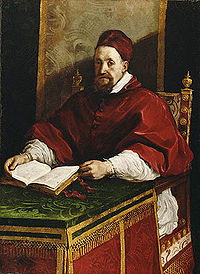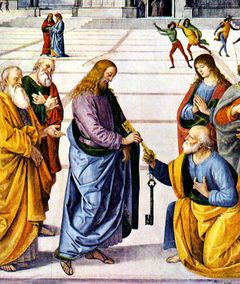Pope Gregory XV
| Gregory XV | |
|---|---|
 |
|
| Papacy began | 9 February 1621 |
| Papacy ended | 8 July 1623 |
| Predecessor | Paul V |
| Successor | Urban VIII |
| Personal details | |
| Birth name | Alessandro Ludovisi |
| Born | 9 or 15 January 1554 Bologna, Papal State |
| Died | 8 July 1623 (aged 69) Rome, Papal State |
| Other Popes named Gregory | |
Pope Gregory XV (9 January or 15 January 1554 – 8 July 1623), born Alessandro Ludovisi, was pope from 1621, succeeding Paul V on 9 February 1621.
Contents |
Biography
| Papal styles of Pope Gregory XV |
|
|---|---|
 |
|
| Reference style | His Holiness |
| Spoken style | Your Holiness |
| Religious style | Holy Father |
| Posthumous style | None |
He was born in Bologna to Pompeo Ludovisi, Count of Samoggia, and Camilla Bianchini, one of seven children.

Educated at the Collegio Romano of the Jesuits in Rome, he went to the University of Bologna to get degrees in canon and Roman law, June 1575. There is no evidence that he ever took orders: his early career was as a papal jurist in Rome. In 1612 Paul V appointed him Archbishop of Bologna and sent him in August 1616 as nuncio to the Duchy of Savoy, to mediate between Charles Emmanuel I, Duke of Savoy and Philip III of Spain in their dispute concerning the Gonzaga Marquisate of Montferrat[1]. In September 1616 Paul created him Cardinal-Priest of Santa Maria in Traspontina. Cardinal Ludovisi remained at his see in Bologna until he went to Rome after the death of Pope Paul V to take part in the conclave in which he was chosen.
At the moment of his election, chiefly through the influence of Cardinal Borghese, at his advanced age (he was 67) and with his weak state of health he saw at once that he would need an energetic man, in whom he could place implicit confidence, to assist him in the government of the Church. His nephew Ludovico Ludovisi, a young man of 25 years, seemed to him to be the right person and, at the risk of being charged with nepotism, he created him cardinal on the third day of his pontificate. On the same day, Orazio, a brother of the pope, was put at the head of the pontifical army. The future revealed that Gregory XV was not disappointed in his nephew. The Catholic Encyclopedia allows that "Ludovico, it is true, advanced the interests of his family in every possible way, but he also used his brilliant talents and his great influence for the welfare of the Church, and was sincerely devoted to the pope." Gregory secured for the Ludovisi two dukedoms, one for his youngest brother Orazio, made a Nobile Romano and duca di Fiano, 1621, and the other, the duchy of Zagarolo, purchased from the Colonna by his nephew Ludovico Ludovisi in 1622. A second nephew, Niccolò, was made reigning prince of Piombino and Lord of the Isola d'Elba in 1634, having married the heiress, 30 March 1632.
Beyond assisting Ferdinand II, Holy Roman Emperor and the Catholic League against the Protestants, to the tune of a million gold ducats, and Sigismund III Vasa against the Turks, he interfered little in European politics. His Constitution against magicians and witches (Omnipotentis Dei, 20 March, 1623) was the last papal ordinance against witchcraft. Former punishments were lessened, and the death penalty was limited to those who were "proved to have entered into a compact with the devil, and to have committed homicide with his assistance" (CE). He was a learned divine and manifested a reforming spirit; his bull of 15 November, 1621, Aeterni Patris regulated papal elections which were to be secret and in writing; three methods of election were allowed: by scrutiny, compromise and quasi-inspiration. On 6 January 1622, he established the Congregatio de propaganda fide the missionary arm of the Roman Curia. His pontificate was marked by the canonisation of Teresa of Avila, Francis Xavier, Ignatius Loyola, Philip Neri, and Isidore the Farmer. He also beatified Aloysius Gonzaga and Peter of Alcantara. He was influential in bringing the Bolognese artist Guercino to Rome, a landmark in the development of the High Baroque style. He sat for his portrait bust both to Gian Lorenzo Bernini and to Alessandro Algardi, whose restrained bust in a tondo is in the church of Santa Maria in Vallicella.
Gregory XV died in the Quirinal Palace on 8 July 1623, and was buried in the church of Sant'Ignazio. He was succeeded by Urban VIII.
Notes
- ↑ The dispute eventually led to the War of the Mantuan Succession, 1628–31.
Bibliography
- Günther Wassilowsky, Hubert Wolf: Päpstliches Zeremoniell in der Frühen Neuzeit – Das Diarium des Zeremonienmeisters Paolo Alaleone de Branca während des Pontifikats Gregors XV. (1621–1623). Rhema-Verlag, Münster 2007, ISBN 978-3-930454-80-8
References
- Catholic Encyclopedia: "Pope Gregory XV"
- Some revised text from the ninth edition (1880) of the Encyclopædia Britannica.
- Cardinals of the Holy Roman Church: Alessandro Ludovisi
- Genealogy of the Ludovisi: Alessandro Ludovisi, no. F3
| Catholic Church titles | ||
|---|---|---|
| Preceded by Scipione Borghese |
Archbishop of Bologna March 12, 1612 – February 9, 1621 |
Succeeded by Ludovico Ludovisi |
| Preceded by Paul V |
Pope February 9, 1621 – July 8, 1623 |
Succeeded by Urban VIII |
|
|||||||||||||||||||||||||||||||||||||||||||||
|
|||||||||||||||||||||||||||||||||||||||||

